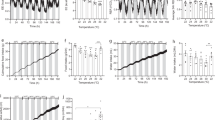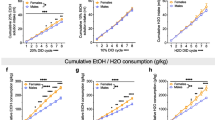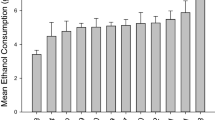Abstract
Diurnal variation in blood and plasma ethanol levels (BACs) has been observed in animals undergoing chronic ethanol treatment, but the information available is insufficient to determine whether the different patterns seen are due to differences in ethanol administration schedules or to strain of the animal. In this study, we have compared plasma ethanol levels in males of two mouse strains with no innate preference for ethanol, TO and CBA, during two commonly employed chronic ethanol treatment schedules. Ethanol was administered in solution as sole drink (CED) (10% or 20% w/v ethanol) for 4 weeks, or in liquid diet form (ELD), (3.5% w/v ethanol for 2 days, then 7% for 5 days). Mice were housed eight per cage on a 12-h light cycle (0900–2100 hours). Plasma ethanol concentration was monitored over the 24-h period. Activity of liver alcohol dehydrogenase (ADH) was measured between 0900 and 1100 hours. CBA mice showed greater variability in body weights than TO mice, which weighed more throughout the period of study and had significantly higher total energy intakes. TO mice consumed more ELD than CBA mice. Following an initial 2-day period of 3.5% ELD, both strains decreased their diet intake when ethanol content of the diet was increased to 7% w/v, which resulted in weight loss. Mice on the CED schedules decreased their fluid intake with increasing concentration of ethanol in the drinking solution. Highest daily ethanol intakes were observed in mice on ELD (19.1 ± 1.7 and 22.2 ± 0.6 g/kg body weight in CBA and TO mice, respectively). Marked diurnal variation in plasma ethanol levels was observed, which was dependent on the treatment schedule, strain and method of ethanol administration. Highest levels were found in mice on the ELD schedule (104.8 ± 7.7 mM in CBA mice, 113.5 ± 14.5 mM in TO mice), peaking at 1900 and at 0900 hours in CBA and TO mice, respectively. Lower plasma ethanol concentrations were reached in mice on the CED schedules, peaking at midnight (34.6 ± 8.1 mM and 35.4 ± 8.8 mM in CBA and TO mice on 20% CED, respectively, and 3.7 ± 1.2 mM and 6.6 ± 2.1 mM in CBA and TO mice on 10% CED). Naive CBA mice had slightly higher liver ADH activity as compared to their TO counterparts. No effect of 10% CED on liver ADH activity was found in either mouse strain. In conclusion, we have confirmed the importance of monitoring plasma ethanol levels during chronic treatment, as there is marked diurnal variation, dependent on the light/dark cycle. Factors such as strain of the animal and the method of delivery of ethanol are also important, whereas liver ADH plays a minor role. Monitoring the daily ethanol consumption is insufficient to predict the resulting plasma levels of the drug.
Similar content being viewed by others
Author information
Authors and Affiliations
Additional information
Received: 19 May 1997 / Final version: 15 December 1997
Rights and permissions
About this article
Cite this article
Jelic, P., Shih, MF. & Taberner, P. Diurnal variation in plasma ethanol levels of TO and CBA mice on chronic ethanol drinking or ethanol liquid diet schedules. Psychopharmacology 138, 143–150 (1998). https://doi.org/10.1007/s002130050656
Issue Date:
DOI: https://doi.org/10.1007/s002130050656




